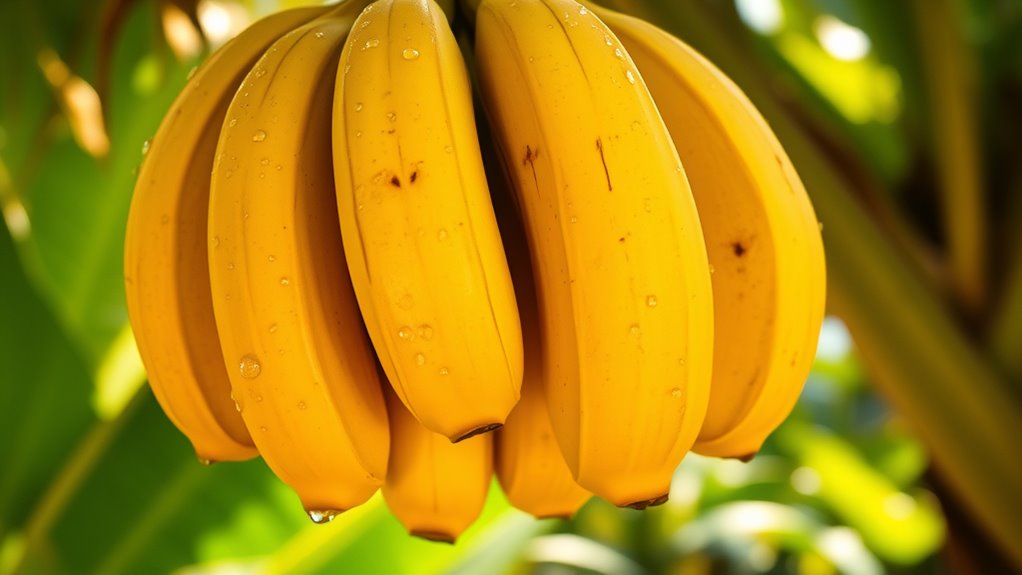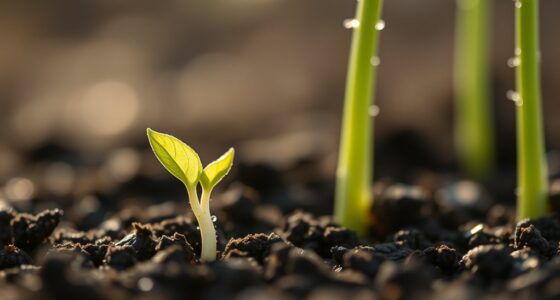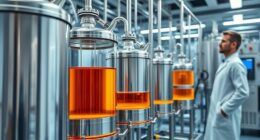Ethylene is a crucial plant hormone that controls fruit ripening and other growth processes. You can use it to manage when fruits mature or extend shelf life by applying ethylene or its inhibitors. Understanding how ethylene biosynthesis works allows you to optimize harvest timing, improve crop quality, and reduce spoilage. Managing environmental factors further fine-tunes its effects. If you want to explore how ethylene can enhance your agricultural efforts, there’s much more to discover.
Key Takeaways
- Ethylene is a plant hormone that regulates fruit ripening and other developmental processes.
- Managing ethylene biosynthesis through applications or inhibitors controls ripening and extends shelf life.
- Exogenous ethylene accelerates ripening; inhibitors delay it, aiding in harvest timing and post-harvest handling.
- Environmental factors influence ethylene production, allowing precise regulation for optimal crop quality.
- Manipulating ethylene responses enhances crop yield, quality, and stress resilience in agricultural practices.

Ethylene is a simple yet powerful plant hormone that plays a essential role in fruit ripening and various other plant processes. When you think about how fruits go from firm and green to soft and flavorful, ethylene is often the key trigger. This hormone is produced naturally in plants through a process called ethylene biosynthesis, where precursor molecules are converted into the active hormone. As a plant matures or encounters specific environmental cues, the rate of ethylene biosynthesis ramps up, signaling the initiation of ripening and other developmental stages. Understanding this process helps you grasp how plants regulate their growth and responses through hormone regulation mechanisms, ensuring they adapt effectively to their environment.
Ethylene triggers fruit ripening and regulates plant growth through biosynthesis and environmental cues.
In your agricultural practices, controlling ethylene biosynthesis is essential for managing fruit ripening and extending shelf life. For instance, you can influence hormone regulation by applying ethylene-releasing compounds or inhibitors to delay or accelerate ripening, depending on your needs. This approach allows you to harvest fruits at their peak quality or transport them over long distances without spoilage. The ability to manipulate ethylene levels gives you a strategic advantage in post-harvest management, reducing waste and improving marketability.
Moreover, ethylene’s role isn’t limited to fruit ripening; it also influences processes like leaf abscission, flower opening, and stress responses. By understanding how hormone regulation works, you can develop targeted strategies to enhance plant resilience or optimize flowering times. For example, applying ethylene inhibitors might prevent premature leaf drop, while exogenous ethylene can hasten flowering in certain crops. Recognizing the connection between ethylene biosynthesis and hormone regulation enables you to fine-tune these responses, leading to better crop yields and quality.
In practical terms, managing ethylene involves monitoring environmental factors such as temperature, humidity, and light, which can influence its production. By controlling these conditions or using chemical treatments, you can effectively regulate ethylene biosynthesis, aligning plant development with your agricultural goals. This precise control over hormone regulation helps you improve efficiency, reduce losses, and meet market demands more effectively.
Frequently Asked Questions
How Is Ethylene Synthesized Commercially for Agricultural Use?
You can produce ethylene commercially through synthesis methods like steam cracking of hydrocarbons, mainly naphtha or ethane. During ethylene production, hydrocarbons are heated at high temperatures, resulting in ethylene gas. This process allows you to efficiently generate large quantities of ethylene for agricultural use, ensuring a steady supply for ripening and other applications. The synthesis methods are optimized for purity and cost-effectiveness to meet industry demands.
What Are the Environmental Impacts of Ethylene Application?
You might think ethylene is harmless, but its application can have hidden impacts. It may cause soil contamination over time, affecting plant health and soil life. Additionally, ethylene releases can subtly worsen air quality, contributing to atmospheric pollution. While it helps crops ripen faster, you should be aware of these environmental risks, ensuring responsible use to protect ecosystems and air purity.
Can Ethylene Be Used to Accelerate Ripening in All Fruit Types?
No, ethylene can’t be used to accelerate ripening in all fruit types because ripening depends on fruit-specific ripening processes and ethylene sensitivity varies among fruits. Some fruits, like bananas and tomatoes, respond quickly to ethylene, while others, like strawberries or grapes, have low sensitivity. You should consider each fruit’s ripening characteristics and ethylene sensitivity to determine if ethylene application will be effective.
Are There Any Health Risks Associated With Ethylene Exposure?
You should be aware that occupational exposure to ethylene can pose toxicity concerns, especially in industrial settings where it’s used or produced. While ethylene is generally safe at low levels, prolonged or high exposure may cause health risks like dizziness or respiratory issues. Always follow safety guidelines and use protective equipment to reduce risk. If you work with ethylene regularly, stay informed about exposure limits to protect your health.
How Does Ethylene Interact With Other Plant Hormones During Ripening?
You might think ethylene acts alone during ripening, but it actually engages in hormonal crosstalk with others like auxins and cytokinins, coordinating the process. These signaling pathways interact dynamically, amplifying or inhibiting each other’s effects to guarantee proper ripening. This complex hormonal interplay ensures fruit ripens uniformly and at the right time, highlighting how ethylene’s role is part of a sophisticated network of plant hormones working together seamlessly.
Conclusion
Now that you understand ethylene’s essential role, you can see how it’s like a conductor guiding fruit ripening. Its applications help farmers harvest at just the right time, reducing waste and boosting profits. By harnessing this natural hormone, you’re tapping into a powerful tool that makes agriculture more efficient and sustainable. Just as a symphony needs a skilled conductor, crops rely on ethylene to reach their perfect ripeness, ensuring delicious, ready-to-eat produce for everyone.








